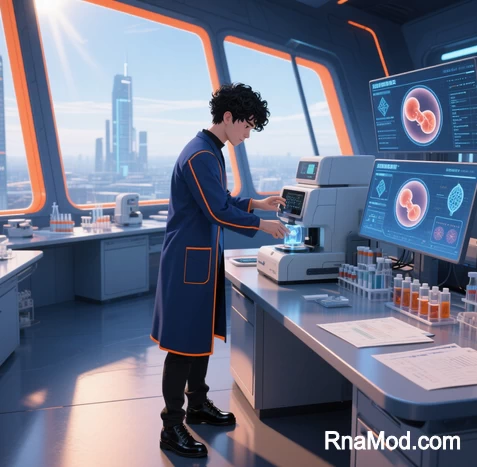 I. Foundational Framework: From Genetic Blueprint to RNA Messenger
I. Foundational Framework: From Genetic Blueprint to RNA Messenger
DNA transcription represents the first critical step in gene expression—a process where genetic information encoded in DNA is converted into complementary RNA sequences. This molecular synthesis enables cells to selectively utilize genomic instructions for protein synthesis, developmental programming, and environmental adaptation. Unlike DNA replication, transcription produces single-stranded RNA molecules that function as transient messengers, catalytic agents, or regulatory elements .
(Fig. 1: The Transcription Workflow)
Description: DNA double helix unwinds at a gene locus. RNA polymerase (blue) synthesizes a nascent RNA strand (red) complementary to the template DNA. Regulatory transcription factors (yellow) bind enhancer/promoter regions.
II. Molecular Machinery: The Transcription Apparatus
A. RNA Polymerase: The Molecular Scribe
RNA polymerase (RNAP) catalyzes RNA synthesis using DNA as a template. Key structural and functional features include:
- Catalytic Core: Mg²⁺-dependent polymerization of ribonucleotides (ATP, UTP, GTP, CTP)
- Processivity: Adds nucleotides at ~50 bp/sec with intrinsic error-correction
- Subunit Composition: Varies between prokaryotes (single multi-subunit complex) and eukaryotes (Pol I/II/III with specialized roles)
| Organism | Polymerase Type | Transcribed RNAs |
|---|---|---|
| Prokaryotes | Holoenzyme (α₂ββ’ωσ) | mRNA, tRNA, rRNA |
| Eukaryotes | Pol II (protein-coding) | mRNA, snRNAs |
| Eukaryotes | Pol I | 28S/18S/5.8S rRNA |
| Eukaryotes | Pol III | tRNA, 5S rRNA |
B. Cis-Regulatory Elements: Genomic Signposts
- Promoters: DNA sequences upstream of genes (e.g., TATA box, BRE, INR) that recruit RNAP and transcription factors (TFs)
- Enhancers: Distal regulatory elements (up to 1 Mb away) that loop chromatin to activate promoters
- Silencers: Repressor-binding sites that block transcription initiation
(Fig. 2: Eukaryotic Promoter Architecture)
Description: Enlarged view of promoter showing TATA box (gold), transcription factor binding sites (TFIID, TFIIB), and RNAP II assembly. Enhancer loop (purple) stabilized by cohesin.
III. The Transcription Cycle: Initiation, Elongation, Termination
A. Initiation: Assembling the Molecular Machinery
- TF Binding: Sequence-specific TFs (e.g., TFIID, SP1) recognize promoter elements
- Preinitiation Complex (PIC): RNAP II + GTFs (TFIIA, B, D, E, F, H) assemble at +1 site
- DNA Unwinding: Helicase activity of TFIIH melts DNA, forming a 14-bp transcription bubble
B. Elongation: Processive RNA Synthesis
- Template Strand Reading: RNAP moves 3’→5′ along DNA, synthesizing RNA 5’→3′
- Topological Challenges: Supercoiling resolved by topoisomerases (DNA gyrase in prokaryotes)
- Proofreading: Pyrophosphorolytic editing removes misincorporated nucleotides
(Fig. 3: Transcription Bubble Dynamics)
Description: RNAP (blue) enclosing melted DNA. Nascent RNA (red) hybridizes transiently with template DNA. Positive supercoils ahead and negative supercoils behind RNAP.
C. Termination: Precision Stopping Mechanisms
| Type | Mechanism | Organisms |
|---|---|---|
| Rho-dependent | Rho helicase disrupts RNA-DNA hybrid | Prokaryotes |
| Intrinsic | GC-rich hairpin + poly-U tract stalls RNAP | Prokaryotes |
| Poly(A)-coupled | CPSF/CstF cleavage triggers disassembly | Eukaryotes |
| Torpedo Model | Xrn2 exonuclease degrades RNA to displace RNAP | Eukaryotes |
IV. Regulatory Complexity: Fine-Tuning Gene Expression
A. Epigenetic Control Layers
- Chromatin Remodeling:
- Histone modifications (H3K4me3 → activation; H3K27me3 → repression)
- Nucleosome repositioning by SWI/SNF complexes
- DNA Methylation: CpG island hypermethylation silences promoters
B. Transcription Factor Dynamics
- Activators: Enhance PIC assembly (e.g., VP16, p53)
- Repressors: Block TF binding or recruit HDACs (e.g., REST, SMRT)
- Cohesin-Mediated Looping: Bridges enhancers to promoters via chromatin looping
(Fig. 4: Enhancer-Promoter Chromatin Loop)
Description: Chromatin loop (purple) bringing distal enhancer (orange) into proximity with promoter-bound RNAP II (blue). Cohesin rings (green) stabilize the loop.
V. Technological Innovations: Probing Transcription at Single-Molecule Resolution
A. Advanced Imaging Methodologies
- Single-Molecule FRET: Quantifies real-time conformational changes in RNAP
- Cryo-EM: Resolves PIC assembly at 2.9 Å resolution (e.g., human TFIID structure)
- Chromatin Conformation Capture (Hi-C): Maps enhancer-promoter interactions genome-wide
B. Synthetic Biology Applications
- Engineered Promoters: T7 RNAP system for high-yield recombinant protein production
- CRISPR-Activation (CRISPRa): dCas9-TF fusions for programmable gene activation
VI. Clinical & Evolutionary Significance
A. Disease-Associated Transcriptional Dysregulation
| Disease | Transcriptional Defect | Consequence |
|---|---|---|
| Cancer | p53 mutation → loss of pro-apoptotic gene activation | Uncontrolled proliferation |
| β-Thalassemia | Mutated promoter → reduced β-globin transcription | Imbalanced α/β-globin chains |
| Rett Syndrome | MeCP2 mutation → aberrant methylation sensing | Neurodevelopmental deficits |
B. Evolutionary Adaptations
- Transcription Factor Duplication: Hox gene family expansion in metazoans
- Promoter Divergence: Lactase persistence alleles with enhanced LCT expression
Conclusion: The Dynamic Transcriptome
“Transcription is not merely a copying mechanism—it is the cell’s master control system for converting static genetic code into dynamic biological responses.”
— Molecular Biology Review
Future frontiers include quantum-dot nanopore sequencing for real-time transcriptional monitoring (2026) and epigenome editing therapies for silencing oncogenes (2028).
Data sourced from publicly available references. For collaboration or domain acquisition inquiries, contact: chuanchuan810@gmail.com.
